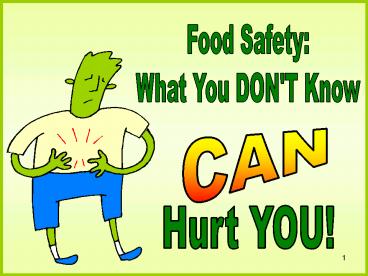Spending Your Calorie Salary PowerPoint PPT Presentation
1 / 52
Title: Spending Your Calorie Salary
1
Food Safety What You DON'T Know
CAN
Hurt YOU!
2
Alice Henneman, MS, RD
Joyce Jensen, REHS, CFSP
Lincoln-Lancaster County Health Dept.
- University of Nebraska-Lincoln Extension in
Lancaster County
I wish Id known these things!
February 2007
Download this PowerPoint at http//lancaster.unl.e
du/food/myths.shtml
3
10 Safety Myths
- Dont be myth- lead!
- Following are the facts for 10 common food
safety myths...
4
Myth 1
- If it tastes O.K., it's safe to eat.
5
Fact 1
- Dont counton these to tell you ifa food
issafe to eat!
6
Estimates of foodborne illnesses in the U.S.
each year
- 76 million peoplebecome ill
5,000 people die
7
- Would this many people eat something if they
thought it tasted, looked or smelled bad?
8
Even if tasting would tell
Why risk getting sick?
- A tiny taste may not protect you.
As few as 10 bacteria could cause somefoodborne
illnesses, such as E. coli!
9
Myth 2
- If you get sick from eating a food, it was from
the last food you ate.
10
Fact 2
- It can take ½ hour to6 weeks to become
sickfrom unsafe foods.
11
- You usually feel OK immediately after eating
and become sick later.
12
Foodborne illness is NOT a pretty picture!
13
Myth 3
- The worst that could happen to you with a
foodborne illness is an upset stomach.
14
Fact 3
Diarrhea
Fever
15
Less common, but possible severe conditions
Paralysis
16
Myth 4
- If Ive never been sick from the food I prepare,
I dont need to worry about feeding it to others.
17
Fact 4
- Some people have a greater risk for foodborne
illnesses. - A food you can safely eat might make others
sick.
Is the food safefor everyone at the table?
18
People with a higher risk for foodborne illness
19
Myth 5
- People never used to get sick from their food.
20
Fact 5
- Many incidents of foodborne illness went
undetected in the past.
21
- Symptoms of nausea, vomiting, and diarrhea were
often and still are blamed on the "flu."
22
Foodborne illness vs. flu
More common in foodborne illness Gastrointestinal More common influ Respiratory
Nausea Chest discomfort
Vomiting Cough
Diarrhea Nasal congestion
Sore throat
Runny or stuffy nose
23
Bacteria have gotten stronger!
24
- Our food now travels farther with more chances
for contamination.
In days gone by, the chicken served at supper
may have been in the hen house at noon!
25
Myth 6
- As long as Ileft the lid on a food that has set
out too long, it is safe to eat.
26
Fact 6
Though food may be safe after cooking, it may not
be safe later.
Just one bacteria in the food can double in 20
minutes!
27
- How many bacteria will grow from one bacteria
left at room temperature 7 hours?
28
2,097,152!
29
- Refrigerate perishable foods within two hours at
a refrigerator temperature of 40F or lower.
30
Myth 7
- If you let a food sit out more than two hours,
you can make it safe by heating it really hot!
31
Fact 7
- Some bacteria, such as staphylococcus (staph),
produce toxins not destroyed by high cooking
temperatures.
32
Myth 8
- If a hamburger is brown in the middle, it is
cooked to a safe internal temperature.
33
Fact 8
- 1 out of 4 hamburgers turns brown before it has
been cooked to a safe internal temperature.
Source United States Department of
Agriculture/Food Safety Inspection Service
http//www.pueblo.gsa.gov/cic_text/food/therm/rese
archfs.htm
34
Which ground beef patty is cooked to a safe
internal temperature?
A
B
Source United States Department of
Agriculture/Food Safety Inspection Service
http//www.pueblo.gsa.gov/cic_text/food/therm/rese
archfs.htm
35
A
B
This is NOT a safely cooked hamburger. Though
brown inside, its undercooked.
This IS a safely cooked hamburger, (internal
temperature of 160ºF), even though pink inside.
Source United States Department of
Agriculture/Food Safety Inspection Service
http//www.pueblo.gsa.gov/cic_text/food/therm/rese
archfs.htm
36
- Research shows some ground beef patties look
done at internal temperaturesas low as 135ºF.
37
(No Transcript)
38
Cook to 160F
39
Food thermometers thin foods
When measuring the temperature of a thin food, such as a hamburger patty, pork chop, or chicken breast, an instant-read digital thermometer should be used, if possible. If using an instant-read dial thermometer, the probe must be inserted in the side of the food so the entire sensing area (usually 2-3 inches)is positioned throughthe center of the food.
40
Myth 9
- Meat and poultry should be washed before cooking.
41
Fact 9
- Washing is NOT necessary or recommended.
42
- Washing increasesthe danger of
cross-contamination,spreading bacteriapresent
on thesurface of meat andpoultry to - ready-to-eat foods
- kitchen utensils
- counter surfaces.
43
- Cooking meat and poultry to the recommended
internal temperature will make them safe to eat.
44
USDA Recommended Safe Minimum Internal
Temperatures
- Steaks Roasts - 145F
- Fish - 145F
- Pork - 160F
- Ground Beef - 160F
- Egg Dishes - 160F
- Chicken Breasts - 165F
- Whole Poultry - 165F
45
Myth 10
- We shouldbe scared of eating almost everything!
46
Fact 10
- ... the American food supply continues to be
among the safest in the world.
Robert E. Brackett, Ph.D., Director, Center for
Food Safety and Applied Nutrition, Food and Drug
Administration, U.S. Department of Health and
Human Services, November 15, 2006 at
http//help.senate.gov/Hearings/2006_11_15/Bracke
tt.pdf
47
I'm not afraid of storms, for I'm learning how to
sail my ship.
- Proper foodhandling helpsassure foodis safe
to eat. 4 steps follow ...
Louisa May Alcott, Author
48
(No Transcript)
49
(No Transcript)
50
(No Transcript)
51
(No Transcript)
52
Remember When in doubt ...
TOSS IT OUT!!!

